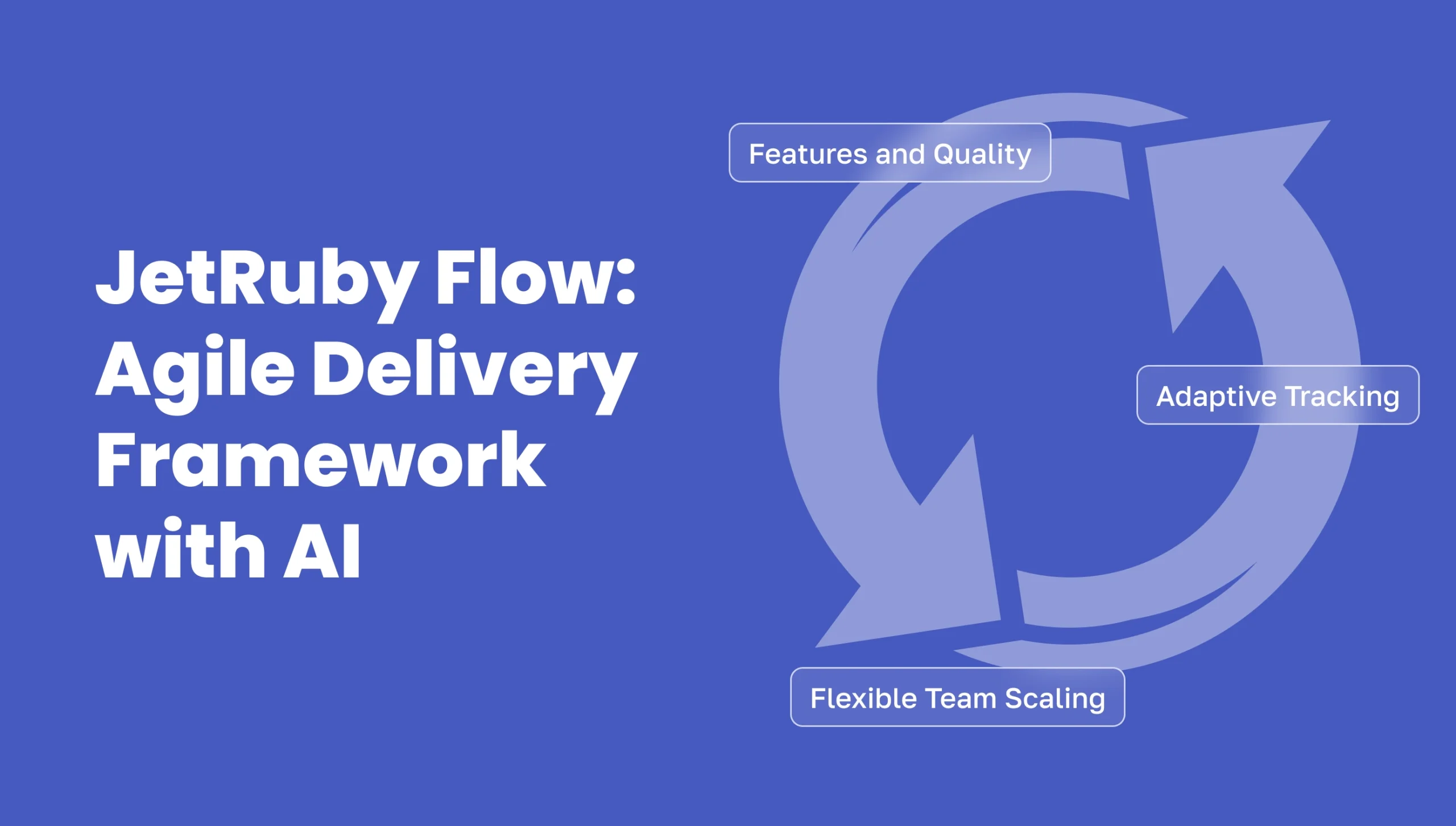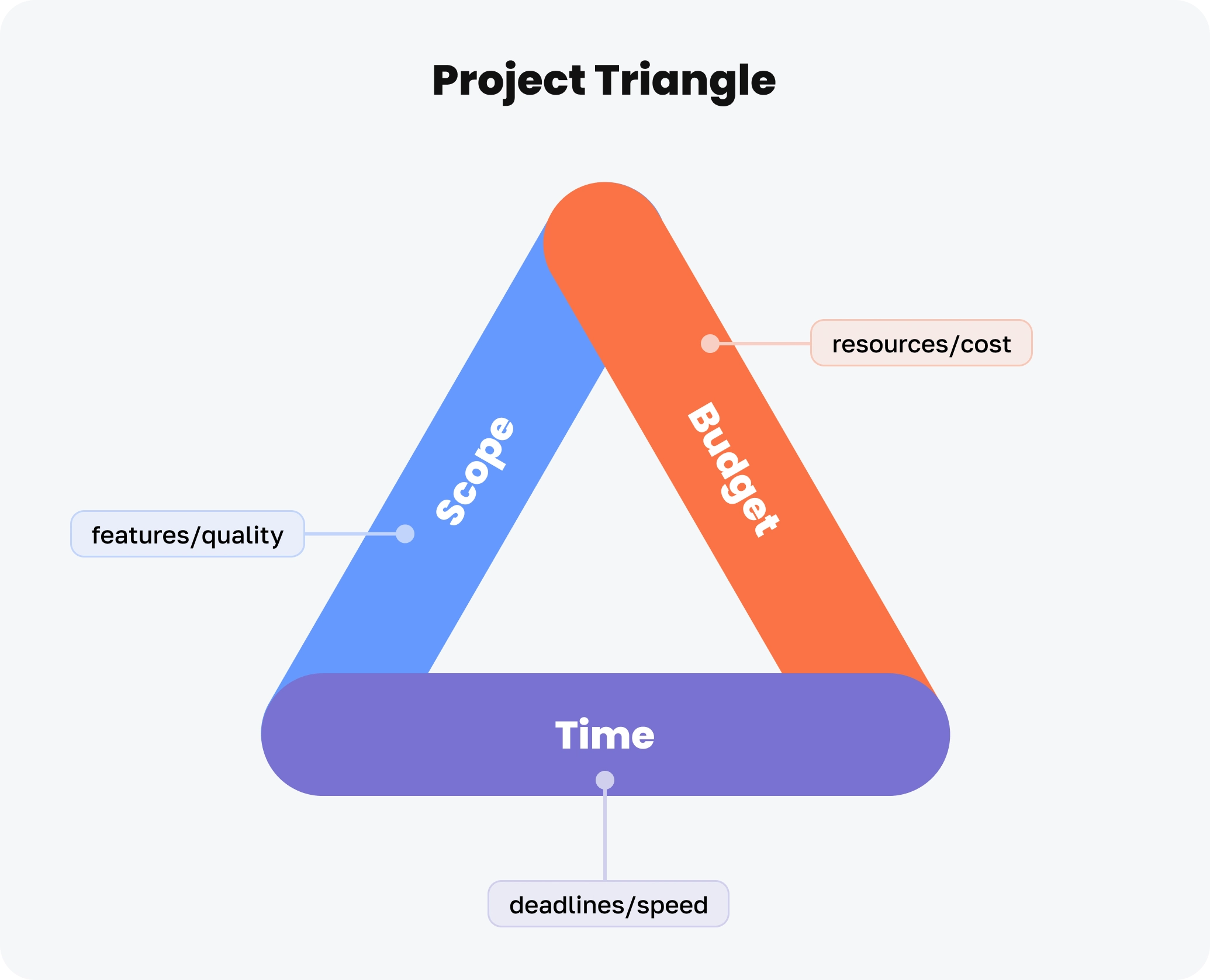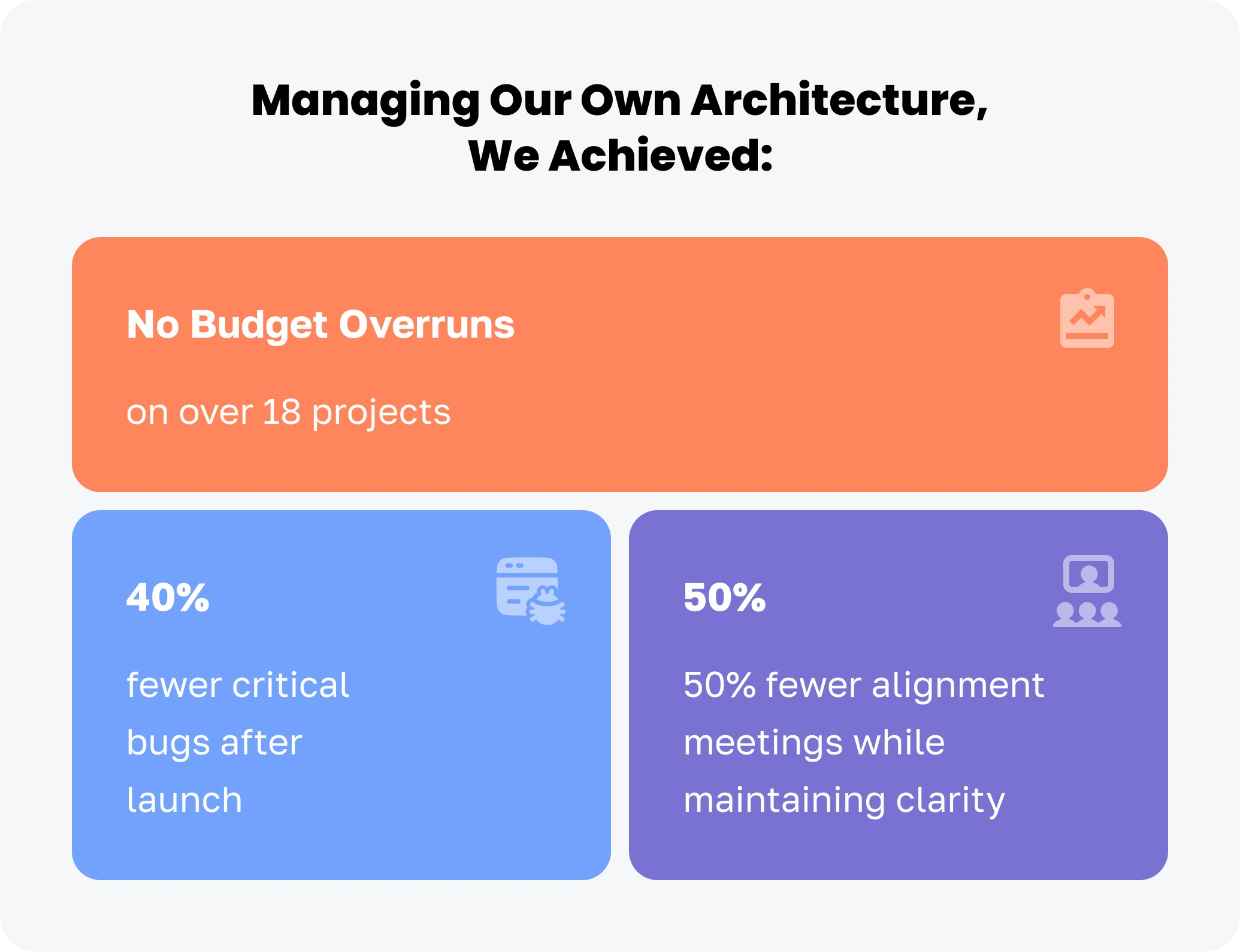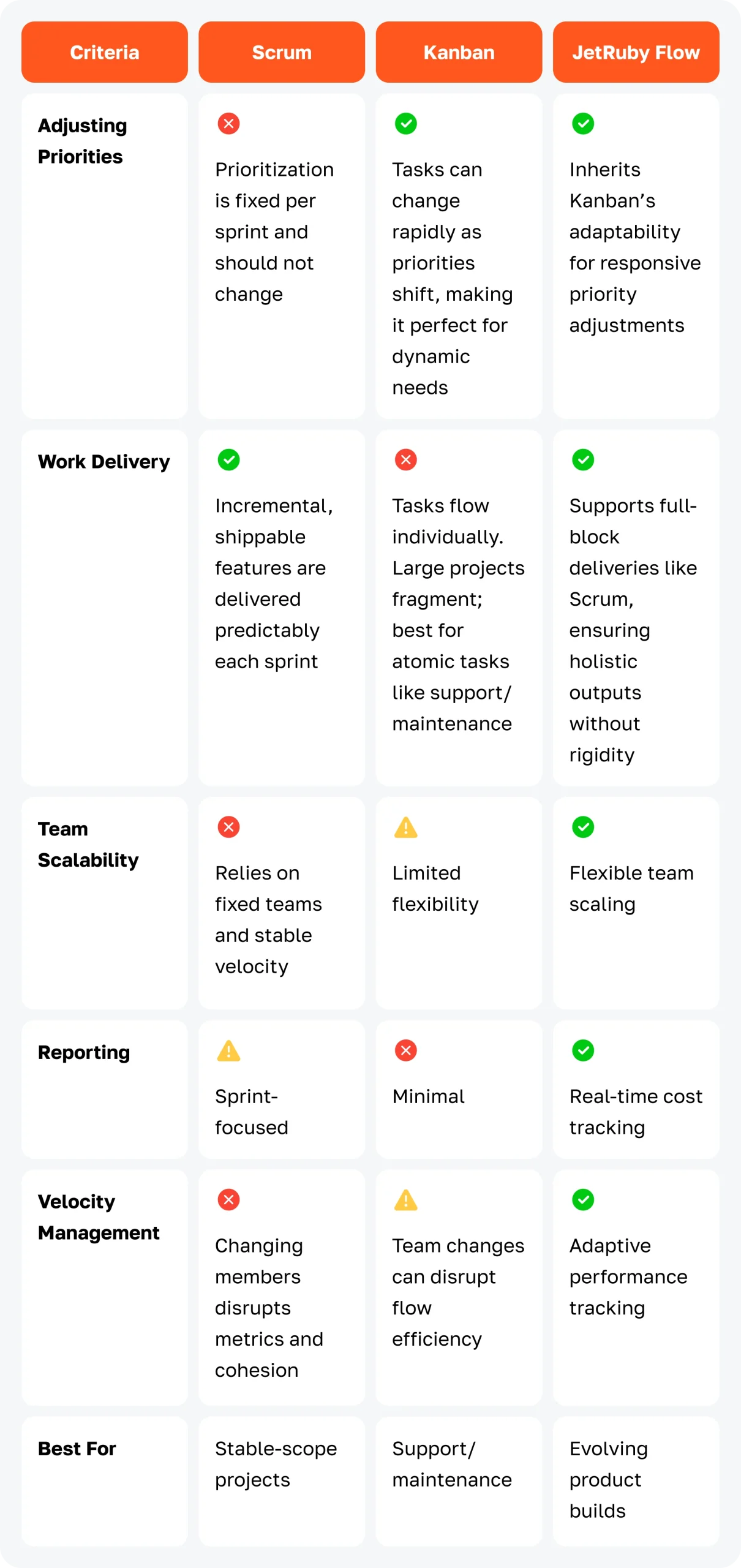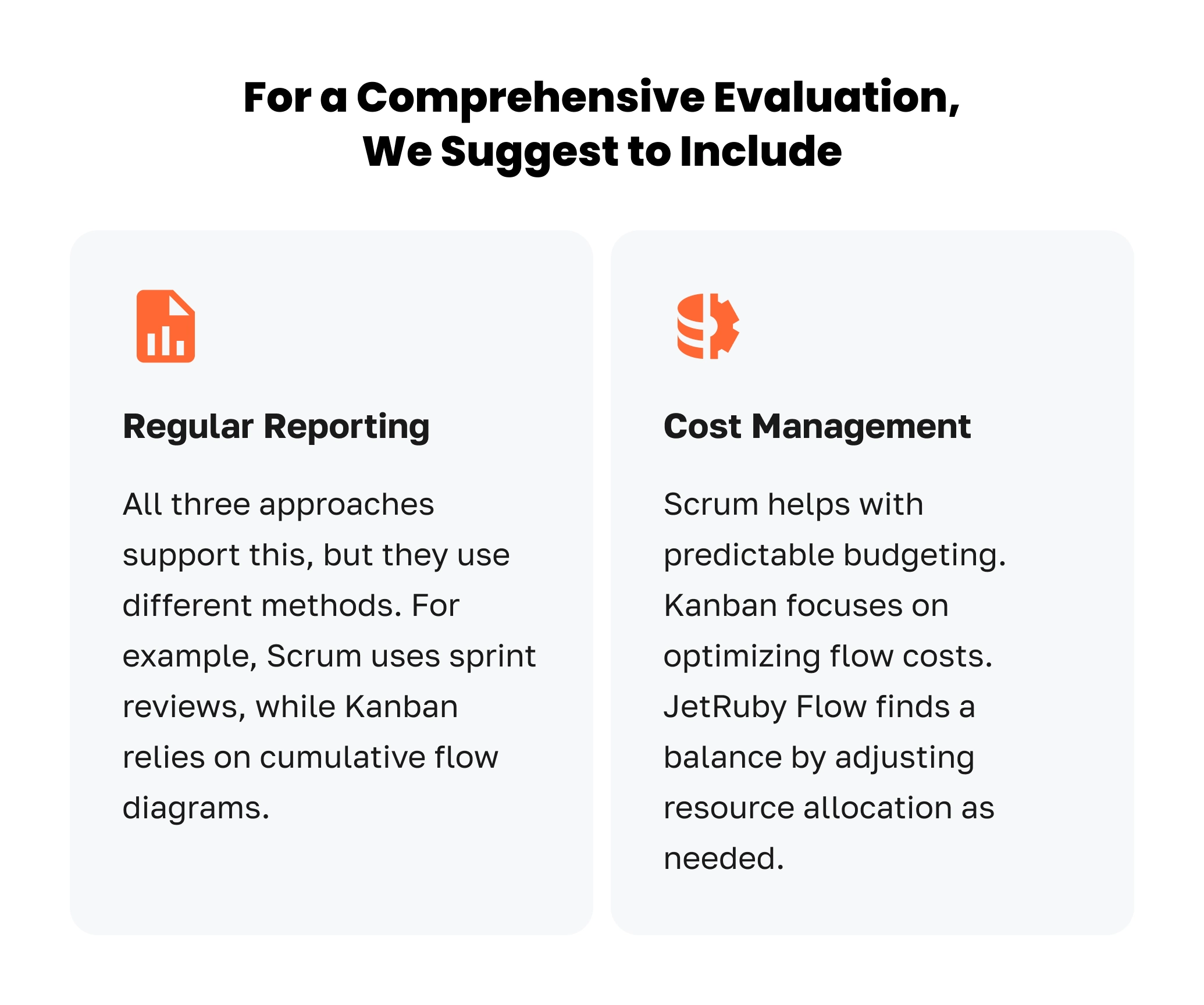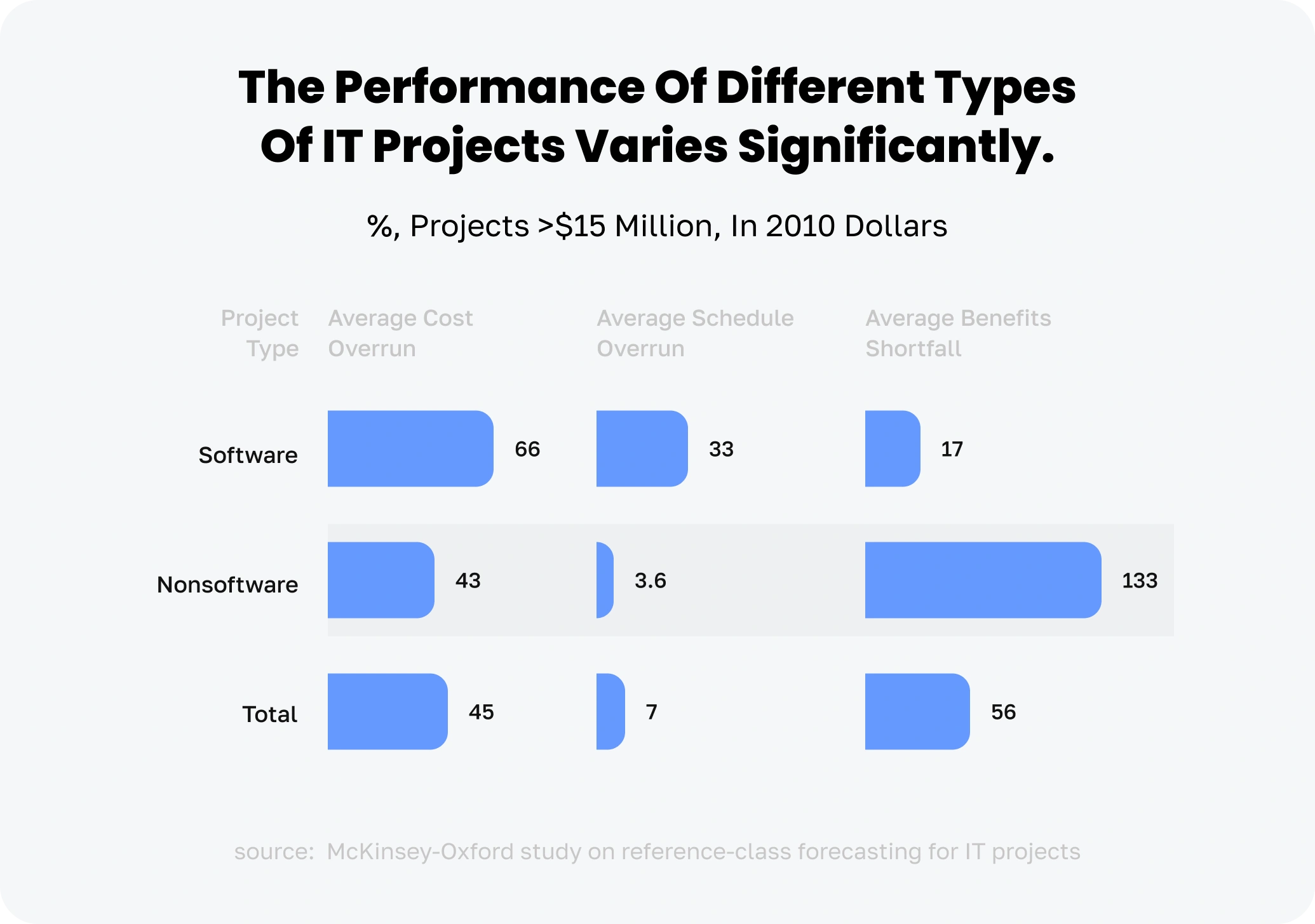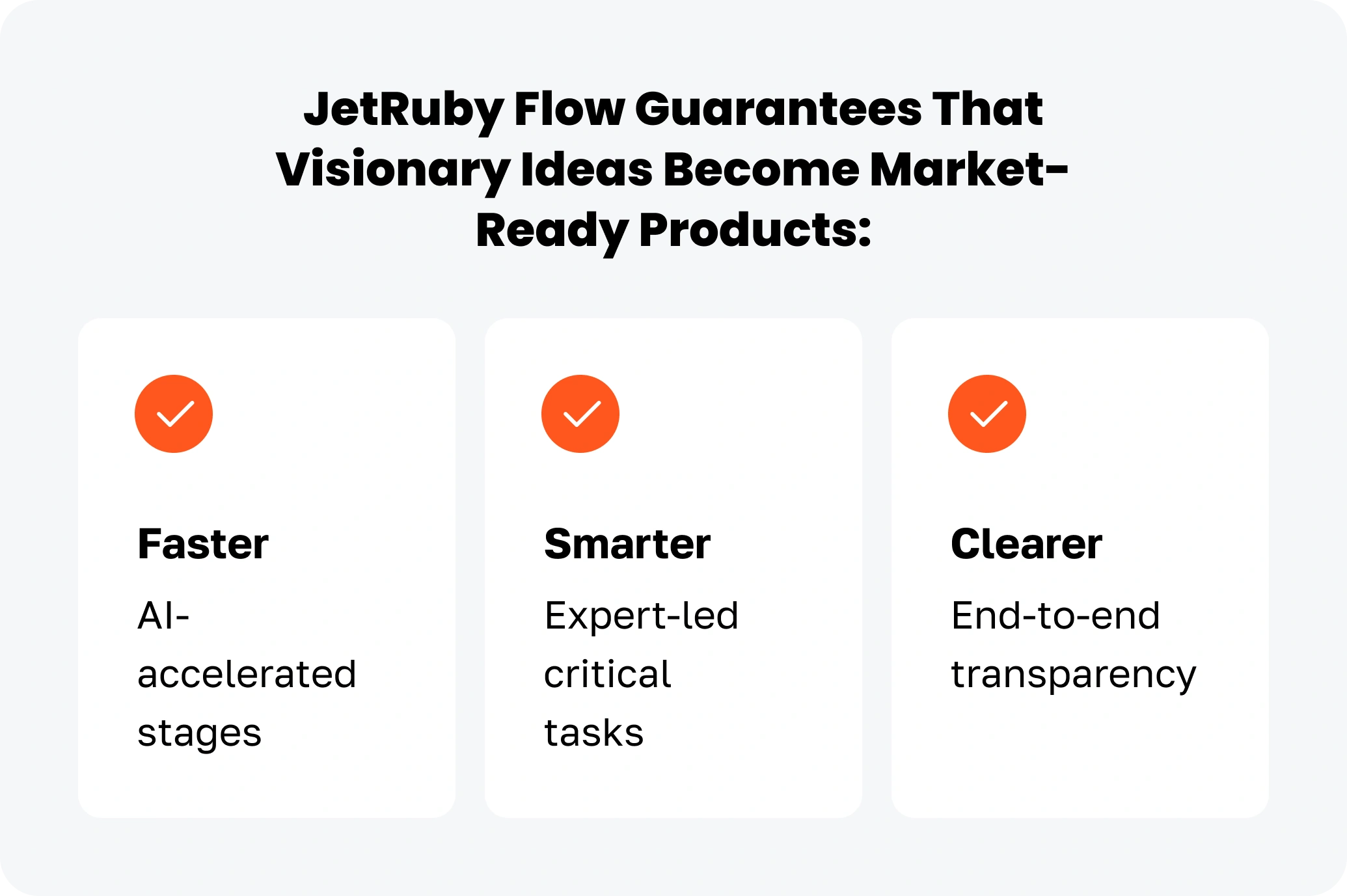Table of Contents
You have a clear vision for a digital product. The market is ready, and your team has the necessary skills.
However, you wonder: Will we actually launch on time, within budget, and meet expectations?
If you feel uncertain, you’re facing a key challenge — the pressure for speed often clashes with predictability, transparency, and quality.
This conflict is not a minor issue. It drains resources, lowers team morale, and results in missed market opportunities.
Traditional methods claim to be agile but can leave clients and teams confused about progress, costs, and launch dates.
JetRuby Flow was created to solve this problem for both our team and our clients.
After 15 years of delivering complex projects and smart AI-assistant solutions, we developed the Flow, JetRuby’s own lean product delivery system. It’s a solution that removes the trade-off between speed and certainty.
The core promise of JetRuby Flow: Speed up your journey from idea to launch with clear updates on timelines, budget, and quality. Flow focuses on efficiency, removes unnecessary barriers, and ensures that everyone involved – your team, our experts, and you – has a shared understanding and confidence at every stage.
Let’s see how this approach changes product delivery from a gamble into a reliable success engine.
Key Takeaways
- You don’t have to choose between rapid delivery and predictable outcomes. A purpose-built framework can harmonize both.
- Treat scope, budget, and time as interdependent variables. Make trade-offs explicit so stakeholders understand their impact on deliverables. (JetRuby’s CTO-as-a-Service model helps structure these decisions clearly).
- Investing upfront in planning, infrastructure, and CI/CD pipelines dramatically reduces risks and speeds up later stages.
- Short sprints with regular demos and budget tracking keep clients aligned and allow course corrections before issues compound.
- Pair performance metrics (velocity, defect counts) with formal reviews every 4–6 weeks to recalibrate priorities and maintain transparency.
- Taking charge of issues and communicating clearly brings “peace of mind” and adds value to efficiency improvements.
Automating routine tasks (documentation, prototyping, code templates) with Figma AI, GitHub Copilot, and custom AI agents frees teams to focus on more strategic tasks. (You can even enhance code review with AI!)
History and Evolution of JetRuby Flow
“JetRuby Flow combines our best practices. We have selected the most effective parts from proven methods and tested them in real projects.”
— Alexey G., Head of Talent Management Discipline
Many traditional software delivery methodologies, such as Agile, Scrum, and Kanban, promise strict procedures but often struggle to fit real-world project needs.
As Alexey points out, “None are used in their pure form.” Teams typically combine these methods, and these on-the-spot adjustments can lead to inconsistency and unexpected outcomes.
JetRuby Flow has developed over 15 years of experience in handling complex projects.
Along the way, we noticed several persistent challenges.
We’ll explore these key hurdles in more detail shortly. We’ll be covering changes in priorities and client expectations, as well as the specific transparency issues with Kanban and flexibility concerns within Scrum.
Our answer is a system built to balance the “Project Triangle”:
Flow turns these factors into a clear equation: changing one area reliably affects the others. For example:
- Reducing the budget will result in longer timelines or a smaller scope.
- Expanding the scope will likely result in higher costs or delays.
We have improved our work with AI. In fact, many clients now embrace AI adoption as a strategic advantage in delivery planning. And there’s one unchanged truth here — the more AI training data AI tools ingest, the smarter and more tailored they become.
This has led to measurable improvements:
– 15% faster idea-to-prototype cycles (using Figma AI)
– 10-35% quicker development (with GitHub Copilot/Cursor)
– 15% better efficiency in gathering requirements (via Anthropic Claude/OpenAI)
“Unlike teams that charge clients for basic ChatGPT access, we use AI purposefully, so our team can concentrate on creativity and critical thinking.”
If you’re building a SaaS solution, check out why Ruby on Rails is ideal for SaaS and explore the best hosting providers.
JetRuby Flow Stages
At JetRuby, our development methodology, JetRuby Flow, helps us deliver high-quality software reliably and efficiently.
This method consists of four stages that are essential to the product lifecycle. We use practical knowledge, hands-on experience, and smart AI tools to enhance our work while ensuring quality and creativity.
Discover the truth behind JetRuby’s Personalized Development Plans that ensure engineer growth!
Stage 1: Zero Sprint — Foundational Planning & Infrastructure Setup
Every project starts with the Zero Sprint.
In this phase, we build a strong foundation. We ensure that all technical and procedural systems are working well before development begins.
Key activities include:
1. Work together to establish primary goals, decide which features to prioritize, and develop the technical design.
2. Set up important tools like CI/CD pipelines, automated testing systems, and project tracking tools
AI Integration in Zero Sprint:
We leverage AI here to accelerate this foundational work:
- Figma AI helps speed up routine design tasks and prototyping.
Our analysis shows it can reduce the time from idea to prototype by about 15%. However, it does not help with the initial creative ideas. - LLMs like Claude and ChatGPT help define business requirements and create test scenarios.
They can reduce result times by 10-15% for summarization and refinement tasks, with further efficiency from JetRuby’s QA and analyst processes for validation.
Note: LLMs work best on projects started by JetRuby. These projects include built-in documentation processes that help cover almost everything from day one.
Stage 2: Agile Development & Iterative Delivery — Building in Cycles
We have built a strong foundation and are now starting Agile Development. We deliver value in short sprints with frequent feedback and clear progress.
- We deliver working features every sprint for early client feedback and review.
- We keep everyone updated with regular demos, progress reports, and budget tracking.
- We conduct thorough automated and manual testing throughout the project.
Stage 3: Performance & Alignment — Continuous Monitoring and Adaptation
This phase runs alongside Stage 2 and helps us stay on track in numbers and strategy, so we can:
- Monitor our productivity, task completion times, and the number of defects.
- Hold formal client reviews every 4 to 6 weeks to change priorities, scope, or timelines as needed.
- Provide detailed reports on efforts to ensure transparent visibility of resources and costs.
AI Integration in Development & Performance:
- Cursor IDE and GitHub Copilot help reduce delivery time by 35% for templatable code and unit tests early in the process, and by 10–15% later on.
- JetRuby Internal AI Agent: Our custom tool, trained on JetRuby standards:
– Generates outputs that comply with our quality and security rules.
– Formats are suitable for immediate use in documents, spreadsheets, or test cases.
– Only requires a human review — no reformatting is needed.
Still unsure about AI benefits? Here’s why you shouldn’t fear of AI taking jobs — it’s here to help you work smarter!
Stage 4: Final Launch & Ongoing Support — Transitioning to Live Operations
We smoothly move approved products to live environments.
- Beta Testing: We test the product in real situations before the full launch.
- Post-Launch Support: We monitor the product, quickly address any bugs, and ensure it runs smoothly.
- Long-Term Partnership: We provide ongoing maintenance, improve performance, and develop new features.
Note!
We move to Stage 4 at major release milestones. Projects can remain in a continuous Agile loop (Stages 2–3) for as long as needed, which is ideal for products that evolve over time.
In Stage 2, we use a standard software development process. Each iteration includes sprint planning, design, development, testing, and release.
Software projects often face retention challenges. See how we reduce employee turnover with a blend of culture and AI.
AI-Enhanced Efficiency
Transform your business! With AI as a powerful support tool, our skilled engineers work more efficiently and effectively, enhancing outcomes and driving profitability!
Get in touch
Real-World Results of JetRuby Flow
When standard ERP systems couldn’t adjust to our hybrid workflows and agile processes, we developed a custom platform that combines operational accuracy with a focus on people.
The outcome has changed how we work together, make decisions, and grow.
We thoroughly tested our development methodology during this project. It worked well whether we coordinated 5 or 30 specialists. We maintained transparency and reduced cycle times by 15% by using AI.
The platform combines core operations, such as payroll, time tracking, and automated administrative tasks, with the Hub’s collaborative features, including real-time mood tracking, JetCoin rewards, and knowledge sharing among teams.
We integrated tools like Jira, Slack, and Superset BI, which helped us remove manual reconciliation as a step and save over 300 hours each month for more strategic work.
- Using automation to sync time logs cut payroll processing time by 40%. Self-service tools also lowered administrative requests by 60%. A project manager summed it up well: “What was a Friday nightmare of chasing updates is now effortless.”
- The JetCoin marketplace and mood analytics increased peer recognition by 30% and boosted retention by 20%. Engineers felt “seen” when mentorship led to real rewards.
- Decisions sharpened: Leadership now uses real-time dashboards that combine project, financial, and feedback data. This speeds up resource decisions by 35% and reduces budget differences by 15%.
So why did customization win?
Pre-built solutions could not adapt to our needs. They forced us into strict workflows and nearly $50k+ customizations.
This ERP system clearly shows how effective JetRuby Flow is.
We completed a 1,200-hour resource module in just 900 hours, which is 25% faster than expected.
“It’s not another software solution. We created an ecosystem where people and processes work well together. The results are clear.”
Looking ahead? Learn what’s new in Rails 8 and future-proof your tech stack.
Comparison with Scrum and Kanban
In modern project management, Scrum and Kanban are the most popular methods used.
Yet, hybrid approaches, like ours, have clear benefits.
Below is a simple comparison of these frameworks that highlights their key differences without making guesses.
Choosing the right project management methodology is about understanding the strengths, trade-offs, and operational rhythms unique to each approach.
Every framework carries its own DNA — a distinct set of unique features that shape how work flows, teams collaborate, and value is delivered.
These characteristics offer advantages in some contexts but can also introduce complexities in others.
Kanban is great for managing small tasks, but has trouble when scaling up. It focuses on how quickly tasks are completed, which works well for support work.
However, managing large projects gets complicated because the deliverables do not stay in sync.
Scrum promotes discipline through fixed time periods, dedicated teams, and regular progress tracking. These features help measure performance.
However, Scrum’s strict structure makes it hard to make changes during a sprint. While the framework works well for predictable tasks, it struggles when flexibility is needed.
So, why JetRuby Flow?
Scrum provides a clear structure for projects, while Kanban offers flexibility. JetRuby Flow combines these two approaches.
- Delivers work completely and promotes teamwork, similar to Scrum.
- Allows for changing priorities and quick responses, like Kanban.
- Can easily expand or shrink teams without losing efficiency, adjusting its pace naturally.
It helps teams manage large projects while staying adaptable to changing priorities and team sizes. This hybrid model is a strong choice for organizations that need to balance efficiency with the ability to adjust as needed.
“JetRuby Flow lets us deliver like Scrum, pivot like Kanban, and scale without penalties. It combines the best of both methods while reducing their drawbacks.”
Client Feedback on JetRuby Flow
JetRuby’s project management method, known as the Jetruby Flow, is not just a series of steps.
It represents 15 years of ongoing improvement in our development process.
This approach guides every client project, providing a clear and flexible route to success. Many clients in various industries, such as logistics, financial technology (FinTech), and agricultural technology (AgriTech), have seen its benefits firsthand.
For instance:
- In Logistics, we develop AI-driven solutions that tackle challenges such as dynamic route optimization, real-time IoT asset monitoring, predictive fleet maintenance, and smart warehouse automation, using computer vision and RFID.
- Within FinTech, our teams build secure systems for AI-powered fraud detection, automated credit scoring, streamlined customer onboarding, conversational banking assistants, and predictive analytics.
- For AgriTech, we develop intelligent solutions with AI for predictive crop analytics, disease detection via computer vision and satellite/drone imagery, smart irrigation control, livestock monitoring, and predictive equipment maintenance.
These examples represent just a few areas where our methodology delivers tangible results.
Let’s take a closer look at one example of our work: Cloudbooking.
Cloudbooking’s rapid growth revealed problems with its IT infrastructure. The Founder and CEO hired JetRuby team to redesign the system completely.
Our team rebuilt the cloud platform using container services.
- We set up a clear CI/CD pipeline, created strong monitoring with reliable alerts, and developed disaster recovery plans.
- We also made staging environments that matched the production setup. This change let Cloudbooking’s engineers focus more on developing the core product.
The effects were immediate: system downtime decreased, deployment cycles sped up, and scaling became easy.
As the CEO remarked, “…the real win was peace of mind. We went from reacting to every hiccup to actually planning ahead.”
JetRuby meets its goals because the team runs every project with discipline:
- We set practical deadlines and move them only when new facts demand it.
- We hold weekly check-ins and track progress on shared dashboards, so everyone stays on the same page.
- We spot security gaps early and patch them right away. That habit builds strong trust with clients.
Our approach supports hiring top talent. Read how we recruit engineers through a rigorous hiring process.
The Future-Proof Delivery Framework
JetRuby Flow is the crystallization of our 15-year journey perfecting product delivery.
By blending battle-tested human expertise with strategic AI automation, we’ve engineered a system that accelerates time-to-market by 10-35% while maintaining ironclad commitments to transparency, budget integrity, and quality.
Software projects run the highest risk of cost and schedule overruns, large IT projects run 45% over budget and 7% over time, while delivering 56% less value than predicted.
JetRuby Flow offers a solution so you don’t have to choose between speed and certainty.
Are you ready to turn delivery into a strength for your business instead of just a cost?
Don’t hesitate to contact JetRuby anytime you see fit!
